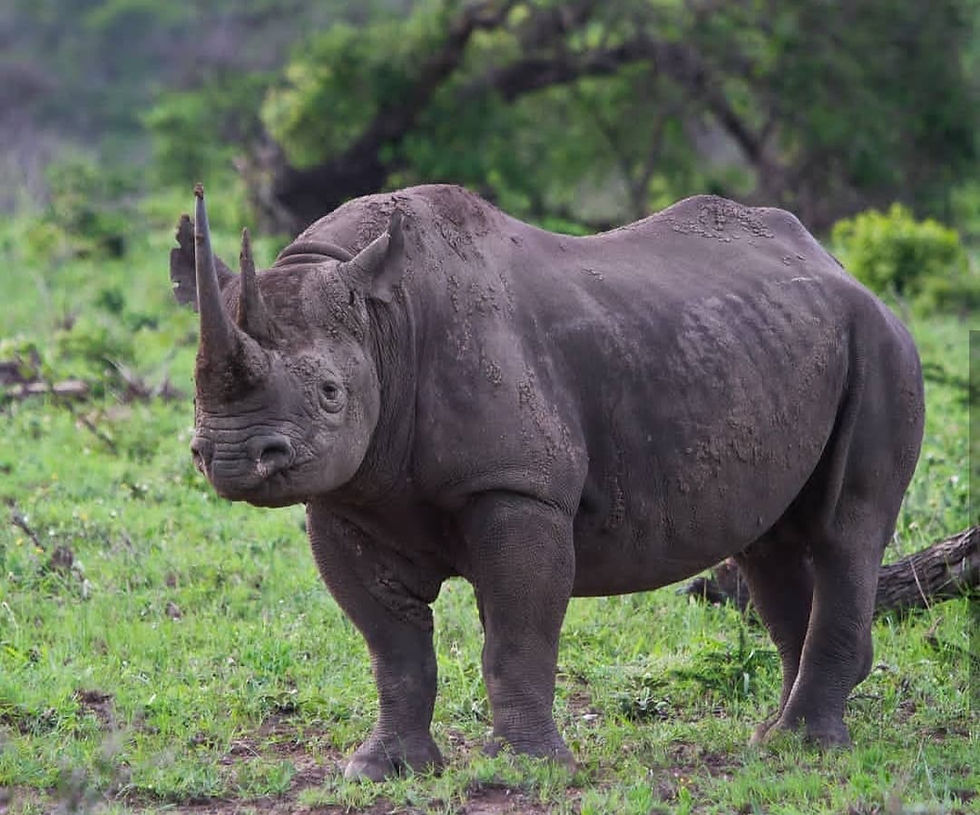The Black Rhino and The 96%
- we are Endangered

- Aug 26, 2018
- 3 min read
Updated: Aug 30, 2018

The black rhino, also referred to as the hook-lipped rhino, has experienced a very different 20th century in terms of their conservation when compared with the other African rhino species. While the white rhino was pulled back from the brink of extinction the black rhino was pushed towards it, succumbing to a massive decline in their population while the white rhino was on the rise. The black rhino began the century as the most abundant of all rhino species with numbers stretching into the several hundred thousand's. Black rhino numbers quickly deteriorated to around 65,000 in the 1970's then to between 10,000 and 15,000 by 1980. By the early 1990's black rhino numbers had declined to under 2,500. This represented a 96% decline of the species in just 20 years; which has become part of the inspiration for The 96% shirt, as well as the motivation to include Save the Rhino International as one of our recommended charities. Read more here about your donation and how you can choose what difference it makes within the world of conservation. How is it we can be in the midst of restoring one rhino species while destroying another?
Rising demand for the use of rhino horn in Asia and the Middle East is one of the biggest contributors to this decline. Vietnam has one of the biggest markets for rhino horn; of the documented arrests of Asian nationals for rhino crimes in South Africa 56% were Vietnamese. Here the horn has cultural importance as it is considered a symbol of power and wealth; which is supported by the underlying beliefs in its health benefits. Unlike other mammals rhino horn does not have a bone core and is made entirely of keratin, the same substance that makes up hair and fingernails. As such it should be obvious that the horn poses no particular medicinal benefits, although this is not the case. According to Tom Milliken, TRAFFIC (Trade Record Analysis of Flora and Fauna in Commerce) rhino expert, the bigger issue here is its uses as recreational drug more so than its traditional uses in medicine. While the value of the horn in these markets can be speculated, it is recommended by wildlife organisations that exact figures are not heavily published; as to not encourage more illegal poaching. CITES (Convention on International Trade in Endangered Species) works closely with both the South African and Vietnamese governments in a bid to prevent illegal rhino horn trade, as these countries represent the biggest trading route for rhino horn, however there is large concern around the political will of Vietnam to make this a priority. While the Asian demand for rhino horn incentivises poaching, it is conditions in Africa which facilitated the huge increase in the poaching of the species.

Poachers have been able to take advantage of rising political instability caused by the numerous conflicts across central and southern Africa; particularly in The Congo (Democratic Republic of) and Zimbabwe, which both show direct links between the rise in conflicts and rhino poaching. During these times government resources are diverted away from conservation, in efforts to stabilise other areas of the country, leaving rhino populations undefended and allowing for high rates of illegal poaching to develop without much resistance. The mass displacement of human populations during these conflicts also aids in the facilitation of rhino horn trade. Conflicts as north as the civil war in Sudan still influence illegal rhino killings in southern Africa due to the high levels of migration. While CITES declared the international trade of rhino horn illegal in the 1970's there is little that can be done to regulate this in countries with these conditions due to the dangers they pose and the prioritisation of resources to humanitarian efforts.
Black rhino numbers are finally increasing and were around the 5,000 mark during the IUCN's last survey. While it is a big improvement to see increases in the species population they are still classified as critically endangered. Through education, new regulations and better engagement between governments we can hopefully effectively manage the survival of the black rhino and prevent periods of excessive decline from reoccurring. £5 from the sale of every 96% shirt goes straight to wildlife conservation, choose from our list of recommended charities or tell us of another and we'll send it there; the choice is up to you.







Comments